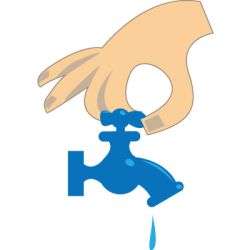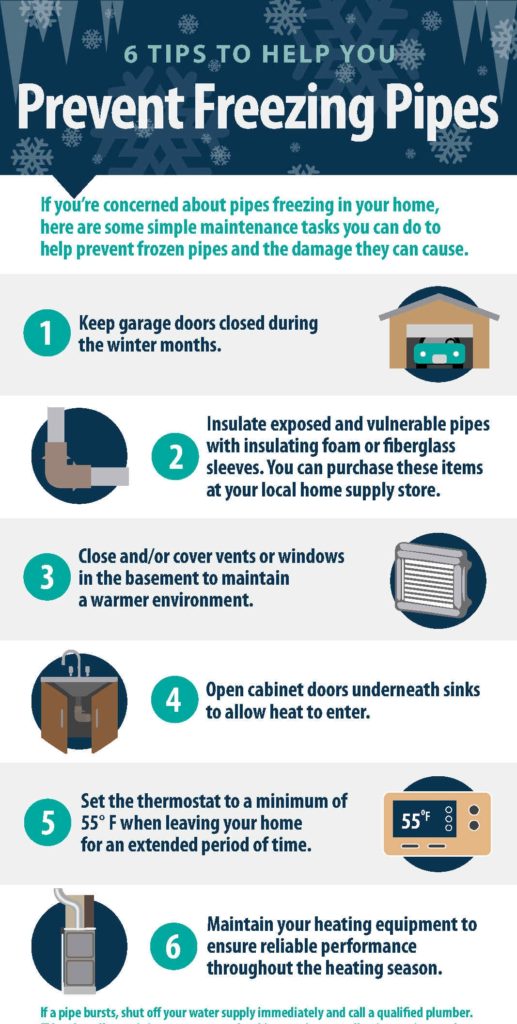Winter Water Usage

Winter usually brings an increase in water usage as some residents keep water running to avoid freezing of water lines.
If you need to do this, remember that the faucet needs to be open only a very small amount; just enough to keep the water moving.
We encourage you to insulate your water lines to avoid needing to run water.
Benefits of Insulating Water Lines
- Save water – the number one priority for Van Anda at present
- Save on your electricity bill – less power to heat the water when not as cold
- Extend the life of your hot water tank as it will not be worked so hard
- Save your septic field – excess water will ruin your septic system
- Avoid damage from frozen pipes bursting if the faucet is accidently closed
Insulating your pipes helps prevent the water inside from freezing if you experience below-freezing temperatures, but it also helps your water heater function more efficiently by keeping the hot-water pipes warm. Plumbers have expensive insulation options, but this project is one any novice homeowner can tackle to insulate pipes without the cost of a plumber.
Which Lines Should I Insulate?
Which of your home’s pipes are at greatest risk for freezing? Any pipe that is not properly protected is vulnerable, but here are a few of the most common locations around your home where pipes can freeze:
- Pipes outside an insulated building, such as swimming pool, sprinkler, and outdoor kitchen supply lines
- Pipes in basements, crawlspaces, garages, and attics
- Pipes running through or along exterior walls
- Pipes in any environment that is not insulated or climate-controlled
Before You Start
The pipes that need insulating are often found in out-of-the-way or dirty areas such as a crawlspace or basement. Clean the pipes thoroughly with water and dish-washing liquid to remove grease, dirt and grime. Although this can seem tedious, it helps your insulation provide the most effective seal and coverage. Give them plenty of time to dry before you start adding the insulation.
Insulating the Lines
Spiral-Wrap Insulation
Usually made of fiberglass covered with a reflective wrap, spiral-wrap insulation comes in a roll-like tape, although it’s not sticky. Wrap the insulation around the pipe, overlapping the edges of the tape by at least 1/2 inch. Use duct tape to hold the ends of the insulation in place or to keep it tight around joints and corners in the pipe. For additional insulation, add a second layer of tape over the first layer.
Using Fiberglass Insulation
Although fiberglass insulation can be bulky, often 2 to 3 inches thick, it’s an inexpensive way to insulate your pipes. Cold-water pipes usually develop condensation, so wrap the insulation in plastic before covering those pipes. You can cut the insulation to fit around the pipe with a utility knife, and seal the seams with duct tape to hold the insulation in place.
Your pipes might not look pretty covered with fiberglass insulation, but they should be kept warm. Always use gloves, eye protection and a dust mask when working with fiberglass insulation to keep the fibers from penetrating your skin, eyes or lungs.
Foam Pipe Covers
Foam pipe covers come in several diameters and lengths and are easy to install, even if you’ve never used them before. Most have a slit cut down one side, allowing you to slide the slit over the pipe to insulate it with the foam. Cut it with scissors or a utility knife, and use duct tape to hold it in place and to seal the slit. This insulation should be slightly larger than your pipe; an air pocket inside the foam offers additional insulation. You can wrap a larger second layer of foam around the first if you need even more insulation. Foam swimming noodles may be a cheaper option.
Spray Foam Insulation
Perhaps the best way to insulate water pipes is by using spray foam, as it is known for being resistant to moisture. According to Do It Yourself, this option is ideal for small spaces, as you can spray the insulation directly onto the pipes. This allows you to custom fit the insulation around the pipes, which is helpful when working under cabinets or inside walls. Another benefit to spray foam is its ability to reduce vibrations.
Shorten Outside Water Lines
If your water supply is through an exposed length of hose, shortening the hose will make it easier to insulate. Ensure that connective parts are secure enough to avoid leaks. Contact our water operators if you need more information about psi ratings (pounds per square inch) for water lines and connections.
Tips to Prevent Pipes from Freezing
- Keep garage doors closed during the winter months.
- Insulate exposed and vulnerable pipes with insulating foam or fiberglass sleeves. You can purchase these items at your local home supply store.
- Close and/or cover vents or windows in the basement to maintain a warmer environment.
- Open cabinet doors underneath sinks to allow heat to enter.
- Set the thermostat to a minimum of 55 degrees when leaving your home for an extended period of time.
- Maintain your heating equipment to ensure reliable performance throughout the heating season.
Performing these basic preventive maintenance tasks can provide peace of mind throughout the cold winter months. We also recommend finding a trusted plumber that has the expertise and resources to respond to an emergency situation whenever it happens, even on a holiday, because emergencies never happen when it’s convenient.
If a pipe bursts in your home, the first thing you should do is immediately shut off the water supply.
Contact our water operators if you need assistance with shutting off the water.
